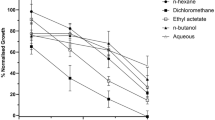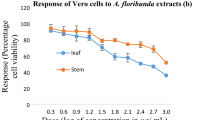Abstract
The extract from Artemisia annua, containing artemisinin, has been proven active against multidrug resistant Plasmodium falciparum in previous studies. The purpose of this paper was to study five Artemisia species from Iran for their in vitro and in vivo antimalarial property and detection of artemisinin in the active species by chromatographic and spectroscopic methods including nuclear magnetic resonance (NMR) spectroscopy. Dried plants were extracted by 80% ethanol, and total extracts were investigated for antiplasmodial property and artemisinin content by TLC, HPLC, and 1H-NMR techniques. Two plants (A. annua L. and Artemisia absinthium L.) showed good antiplasmodial activity against multidrug resistant and sensitive strain of P. falciparum. A. absinthium and A. annua at concentrations of 200 mg/kg for 4 days reduced parasitemia in BALB/C mice infected with Plasmodium bergei by 94.28% and 83.28%, respectively, but we could not detect artemisinin in all plants studied in this research. The antiplasmodial property of these two herbs is possibly related to essential oils that present in high amounts in their extracts.

Similar content being viewed by others
References
Arab HA, Rahbari S, Rassouli A, Moslemi MH, Khosravirad F (2006) Determination of artemisinin in Artemisia sieberi and anticoccidial effects of the plant extract in broiler chickens. Trop Anim Health Prod 38:497–503
Beljaev AE (2000) The malaria situation in the WHO eastern Mediterranean region. Med Parazitol 2:12–15
Castilho PC, Gouveia SC, Rodrigues AI (2008) Quantification of artemisinin in Artemisia annua extracts by 1H-NMR. Phytochem Anal 19:329–334
de Ridder S, van der Kooy F, Verpoorte R (2008) Artemisia annua as a self-reliant treatment for malaria in developing countries. J Ethnopharmacol 120:302–314
Edrissian GH, Shahabi S (1985) Preliminary study of the response of Plasmodium falciparum to chloroquine in Sistan and Baluchestan province of Iran. Trans R Soc Trop Med Hyg 79:563–564
Farzaneh M, Ahmadzadeh M, Hadian J, Tehrani AS (2006) Chemical composition and antifungal activity of the essential oils of three species of Artemisia on some soil-borne phytopathogens. Commun Agric Appl Biol Sci 71:1327–1333
Ferreira JF, Gonzalez JM (2009) Analysis of underivatized artemisinin and related sesquiterpene lactones by high-performance liquid chromatography with ultraviolet detection. Phytochem Anal detection 20:91–97
Finney DJ (1949) The adjustment for a natural response rate in probit analysis. Ann Appl Biol 36:187–195
Groombridge B (1992) Global biodiversity: status of the earth's living resources. Chapman and Hall, London, pp 64–87
Hsu E (2006) The history of qing hao in the Chinese materia medica. Trans R Soc Trop Med Hyg 100:505–508
Kindermans JM, Pilloy J, Olliaro P, Gomes M (2007) Ensuring sustained ACT production and reliable artemisinin supply. Malar J 6:125
Knight DJ, Peters W (1980) The antimalarial action of N-benzyloxy dihydrotriazines. The action of cycloguanil (BRL50216) against rodent malaria and studies on its mode of action. Ann Trop Med Parasitol 74:393–404
Kondrashin AV, Rooney W (1992) Overview: epidemiology of malaria and its control in countries of the WHO South-East Asia region. Southeast Asian J Trop Med Public Health 23(Suppl 4):13–22
Krishna S, Bustamante L, Haynes RK, Staines HM (2008) Artemisinins: their growing importance in medicine. Trends Pharmacol Sci 29:520–527
Kurtzhals JA (2005) Ineffective change of antimalaria prophylaxis to Artemisia vulgaris in a group travelling to West Africa. Ugeskr Laeger 16:4082–4083
Liu C, Zhao Y, Wang Y (2006) Artemisinin: current state and perspectives for biotechnological production of an antimalarial drug. Appl Microbiol Biotechnol 72:11–20
Makler MT, Ries JM, Williams JA, Bancroft JE, Piper RC, Gibbins BL, Hinrichs DJ (1993) Parasite lactate dehydrogenase as an assay for Plasmodium falciparum drug sensitivity. Am J Trop Med Hyg 48:739–741
Marchand E, Atemnkeng MA, Vanermen S, Plaizier-Vercammen J (2008) Development and validation of a simple thin layer chromatographic method for the analysis of artemisinin in Artemisia annua L. plant extracts. Biomed Chromatogr 22:454–459
Mclaughlin JL, Rogers LL, Erson JE (1998) The use of biological assays to evaluate botanicals. Drug Inf J 32:513–524
Misra P, Pal NL, Guru PY, Katiyar JC, Tandon JS (1991) Antimalarial activity of traditional plants against erythrocytic stages of Plasmodium berghei. Pharm Biol 29:19–23
Mueller MS, Karhagomba IB, Hirt HM, Wemakor E (2000) The potential of Artemisia annua L. as a locally produced remedy for malaria in the tropics: agricultural, chemical and clinical aspects. J Ethnopharmacol 73:487–493
Olumnese P (2006) WHO Guidelines for the treatment of malaria. WHO, Geneva
Padmaja R, Arun PC, Prashanth D, Deepak M, Amit A, Anjana M (2002) Brine shrimp lethality bioassay of selected Indian medicinal plants. Fitoterapia 73:508–510
Ramezani M, Fazli-Bazzaz BS, Saghafi-Khadem F, Dabaghian A (2004) Antimicrobial activity of four Artemisia species of Iran. Fitoterapia 75:201–203
Rucker G, Walter RD, Manns D, Mayer B (1991) Antimalarial activity of some natural peroxides. Planta Med 57:295–296
Sayyah M, Nadjafnia L, Kamalinejad M (2004) Anticonvulsant activity and chemical composition of Artemisia dracunculus L. essential oil. J Ethnopharmacol 94:283–287
Snow RW, Trape JF, Marsh K (2001) The past, present and future of childhood malaria mortality in Africa. Trends Parasitol 17:593–597
Trager W, Jensen JB (1976) Human malaria parasites in continuous culture. Science 193:673–675
Wanger H, Bladt S, Zgainski EM (1984) Plant drug analysis. Springer, Heidelberg, Translated by Scott A
Wichtl M (1989) Teedrogen, 2. Auflage, Wissenschaftliche Verlagsgesellschaft mbH, Stuttgart
Zargari A (1987) Iranian medicinal plants, vol 3. Tehran University Publications, Tehran
Acknowledgments
Authors wish to thank Pasteur Institute of Iran for partial financial funding and support of the project (Grant no. 289). In addition, the authors would like to express their appreciation to Blood Transfusion Organization, Tehran, Iran for providing the blood and serum in this project. The authors are grateful to Professor M. Hommel (Liverpool School of Tropical Medicine) and Dr. H. Baseri (Department of Medical Entomology, School of Public Health, Tehran University) for providing K1, CY27 strains of P. falciparum and P. berghei (ANKA), respectively.
Author information
Authors and Affiliations
Corresponding author
Rights and permissions
About this article
Cite this article
Ramazani, A., Sardari, S., Zakeri, S. et al. In vitro antiplasmodial and phytochemical study of five Artemisia species from Iran and in vivo activity of two species. Parasitol Res 107, 593–599 (2010). https://doi.org/10.1007/s00436-010-1900-4
Received:
Accepted:
Published:
Issue Date:
DOI: https://doi.org/10.1007/s00436-010-1900-4




